Bosnia-Herzegovina is one of those countries that raised eyebrows whenever I told someone I was headed there. Those who had no idea where it was had a vague notion that it was dangerous; those who knew the country were under the impression that it was still at war.
Bosnia, as it is often called, does indeed have a recent history of war. Josip Broz Tito, President-for-Life of Yugoslavia, was the glue that held the former Yugoslav countries together. Within three years of his death in 1980, it had separated into six different republics, with boundaries loosely established according to ethnicity. The area where Slovenes lived became Slovenia. The lands that were home to Croats became Croatia. Serbia was populated by Serbs, Macedonia by Macedonians, Montenegro by Montengrins. The population of Bosnia-Herzegovina, however, was a mixture of Muslim Bosnians, Orthodox Serbians, and Catholic Croatians, and everyone seemed to want a piece of the Bosnian pie. When Serbians invaded Bosnia in 1991, Mostar found itself at the epicenter of the conflict.
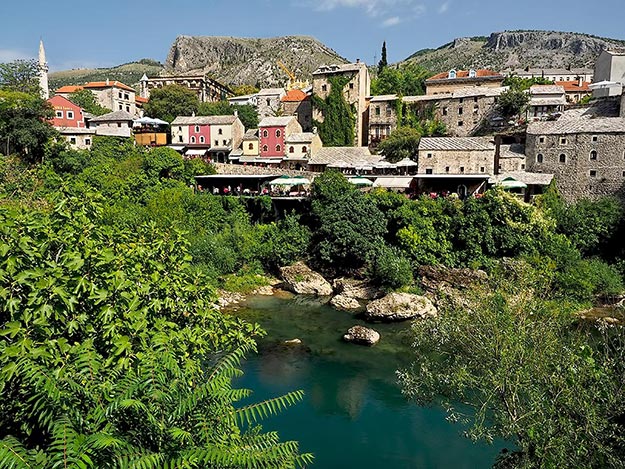
Almir Taso, owner of Hercegovina Hostel, was 12 when the war broke out. He remembers those horror-filled times vividly. Initially the Serbians invaded from the east. Bosnians and Croats, who had lived together peacefully in Mostar for generations, fought the Serbian forces, driving them into the mountains on the eastern side of the city. From this higher ground, Serbs relentlessly shelled the town, gradually reducing it to a pile of rubble.
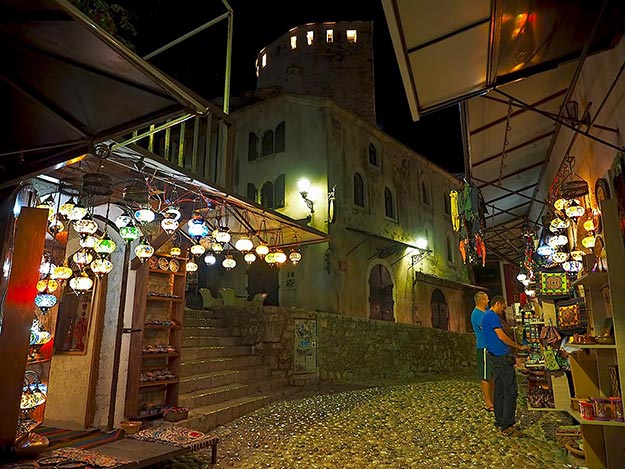
In 1993, Serbian President Slobodan Miloševic and Croatian President Franjo Tudjman met and secretly agreed to carve up Bosnia-Herzegovina between them, with the Neretva River that runs through the center of Mostar the intended dividing line. All land to the west of the river would become part of Croatia, while lands to the east would become part of Serbia.
Overnight, Croatian soldiers became mortal enemies of Bosnians. A woman who today works at one of the museums in Mostar was 20 at the time. “The Croatian soldiers came to our house and forced us to leave with only this,” she said, indicating her dress, “and our lives.” Bosnians fled to the eastern side of the Neratva River, where they were sandwiched between Serbian and Croatian forces, living in cellars beneath the piles of rubble that had once been their homes.
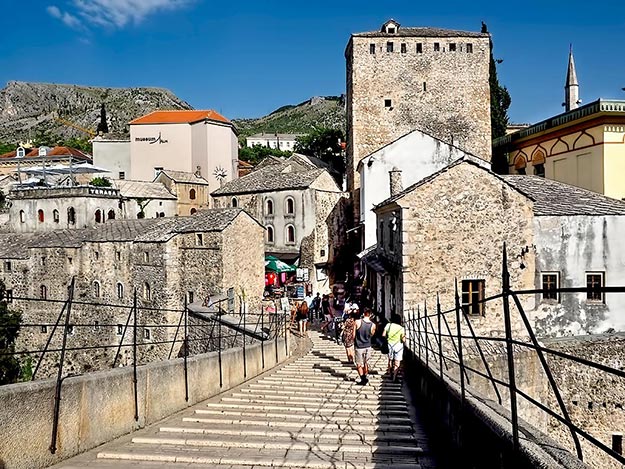
“For three years, we had no electricity, no water, no food,” said Tosh. “We collected rainwater or boiled water from the river for drinking. Sometimes I could shoot a pigeon for food.” By then, Tosh had turned 15 and he brooded over not being able to complete a right of passage expected of all Mostar men. For decades, every young man in the town had jumped into the river from the top of Stari Most, the 16th century bridge in the center of town, marking their transition from boyhood to manhood. Not only was it dangerous to go out during the day, the Serbs were regularly shelling the bridge because it was an important symbol to Muslims. Its high arch reflected in the river, creating a near perfect oval that represented the circle of life.
“I decided I would rather die jumping off the bridge than in the war, so I sneaked out one day and took the plunge. Three months later, the bridge was completely destroyed. I was one of the last young men to perform our rite of passage.”
Even the very young have vivid memories of those terrible years in Mostar. Vedad, my server at a restaurant I frequented, was only five when the war broke out. His family moved in with cousins whose house on the east side of town had a large basement that had survived the bombings. “There were so many people living together in the basement, because there were so few safe places to stay. We picked apples and figs and made pies to eat, though usually without flour or oil. No trucks could get in or out, and even if we could find flour it was priced as high as 50 Euros per kilo.”
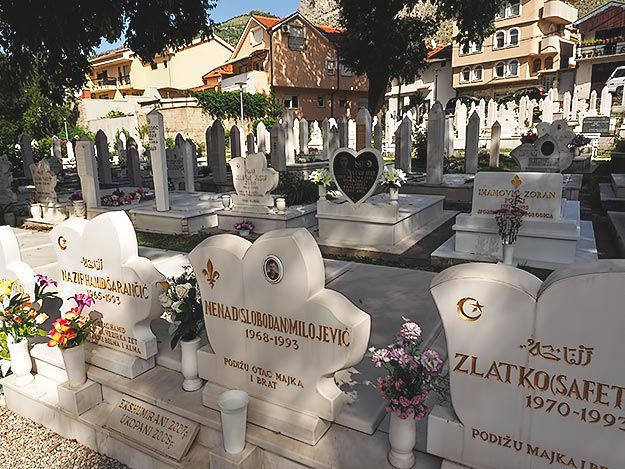
The war in Mostar finally ended in 1994, after U.S. President Bill Clinton called Tudjman and demanded that he withdraw Croatian forces. Serbia followed suit, but not before 150,000 Bosnian Muslims had been killed. Twenty years later, many residents still find it painful to talk about those days. Both the woman at the museum and my server became visibly emotional during our conversations, the latter holding out his arm to show me the goosebumps that had broken out as he spoke. Though many are reluctant to speak of those days, reminders are everywhere. Signs declare “Don’t Forget” and a hill in the center of town is covered with row upon row of stark white tombstones, almost all of them belonging to young men who perished in 1993 at the height of the war.
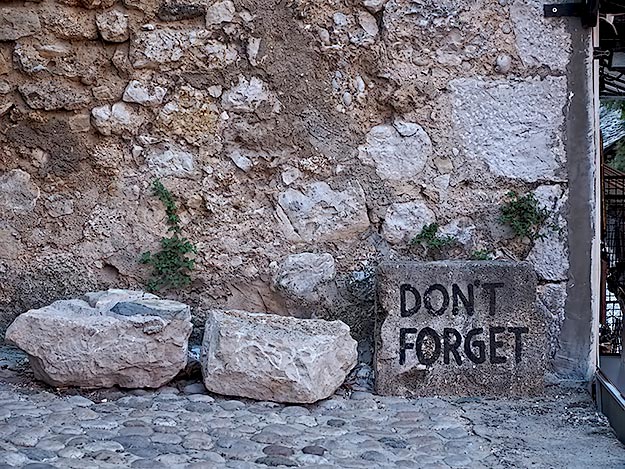
Though not forgotten, Bosnians seem to be willing to forgive. Once again, all three ethnic groups are living together, with the largest portion of the population being Bosnian. On the surface, things are peaceful, but institutions like schools reveal that tensions still exist. Serbian and Bosnian children in the same schoolhouse are segregated and learn different histories and religion. Though technically all three speak Serbo-Croatian, laws now require that government notices be written in all three languages, which has resulted in some bizarre situations. Cigarettes, for example, must carry a government warning about the dangers of smoking. Three sentences are printed at the bottom of each pack: two use the Latin alphabet and are exactly the same, one for Croatian and the other for Bosnian. The third is printed in Cyrillic letters, which, along with Latin, is one of the two official alphabets of Serbia.
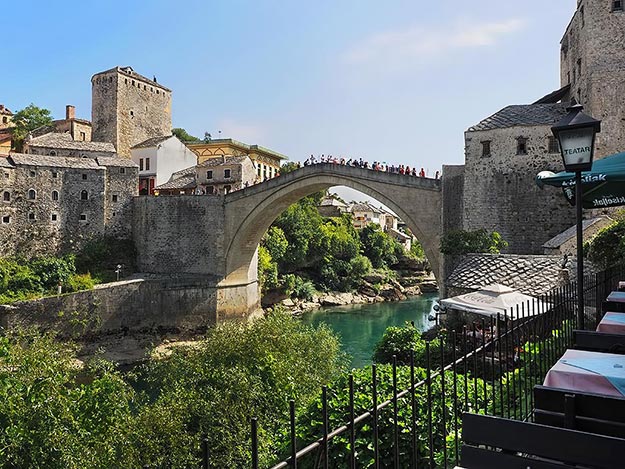
Still, the casual visitor will not notice any of this. Catholic and Orthodox church steeples mingle with minarets on the skyline and though the occasional bombed-out building can still be seen, for the most part, the town has been entirely restored. Its most famous attraction, Stari Most, was rebuilt using the exact same methods employed by the original builders in the 1600’s. The new bridge, an exact replica of the original, once again casts its circular reflection on the Neratva River, and the town’s young men have resumed jumping from it, though they now pass a hat among tourists before doing so.
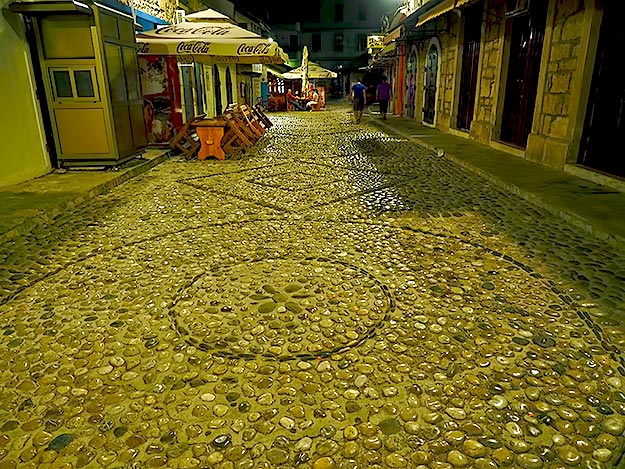
Today, Mostar has an easy, chilled out vibe and the town is so safe that most residents don’t even lock their doors. Among Balkan countries, Bosnia-Herzegovina is experiencing the highest growth in tourism, and Mostar is the second most popular destination in the country after Sarajevo. This results in huge crowds during high season, but most are day-trippers who arrive by the bus load around 10 a.m. and depart by 3 p.m., thus the secret of visiting Mostar is to stay overnight. After the crowds depart, locals are happy to sip Bosnian coffee with you and discuss how the circle of life continues.

Hi Barbara. I am really enjoying your blog. Great writing. Informative yet entertaining. And especially Mostar articles, me being a Mostar native, but currently living in KY, USA. Having lived through the war myself I am so glad that Mostar finally emerged from the ashes and built the infrastructure it deserves. We were pretty stunned how much city has been built up over the past 15 years, but ethnic tensions are unfortunately still there.
Wife and I are actually going back to Mostar and her country of Serbia next week for a month long visit.
Love the photos.
Regards,
Hi Vanja: Thanks so much for your comment. I really loved Mostar, and Bosnia and Herzegovina in general. However, I know what you mean when you say the tensions are still there. There is still so much animosity – from tour operators to the messages scrawled on rocks and walls – and healing seems a long way off. I came away feeling that tensions could erupt again, at any time. I pray this does not happen. By now, you are probably winging your way back to your homeland. I wish you a wonderful stay!
I go to mostar in september i look forward to it so much your articel made me reflect on problems it has had there, i recently had a heart attack but i intend to walk over the old bridge (not jump) before the ticker packs in for good, thank you for your article. kind regards wizbot
Hi Brian: Thanks so much for your comment and letting me know you enjoyed my story. I loved Mostar, and the bridge is just magnificent. I hope you do make it there and walk over it.
Wow, it’s not often that I read about people visiting Bosnia!
I went last year and absolutely adored it!
It’s one of the best kept secrets of Eastern Europe, in my opinion Audrey. I also loved it there, and as a bonus, Bosnians make the best coffee in the world.
This is the best post .I have a Plane to visit Sarajevo .Its a very good place to visit rich or culture and nature.
Hope you enjoy Sarajevo Dominic 🙂
This is an excellent and educational post — thank you! I plan to go to Mostar and Sarajevo in June but I hadn’t been planning to stay over in Mostar. I didn’t know it was a tourist magnet. As you advise, I’ll spend the night.
Happy holidays!
Libbie
Hi Libbie: You won’t be disappointed. There is so much to do in Mostar that a day trip doesn’t even scratch the surface.